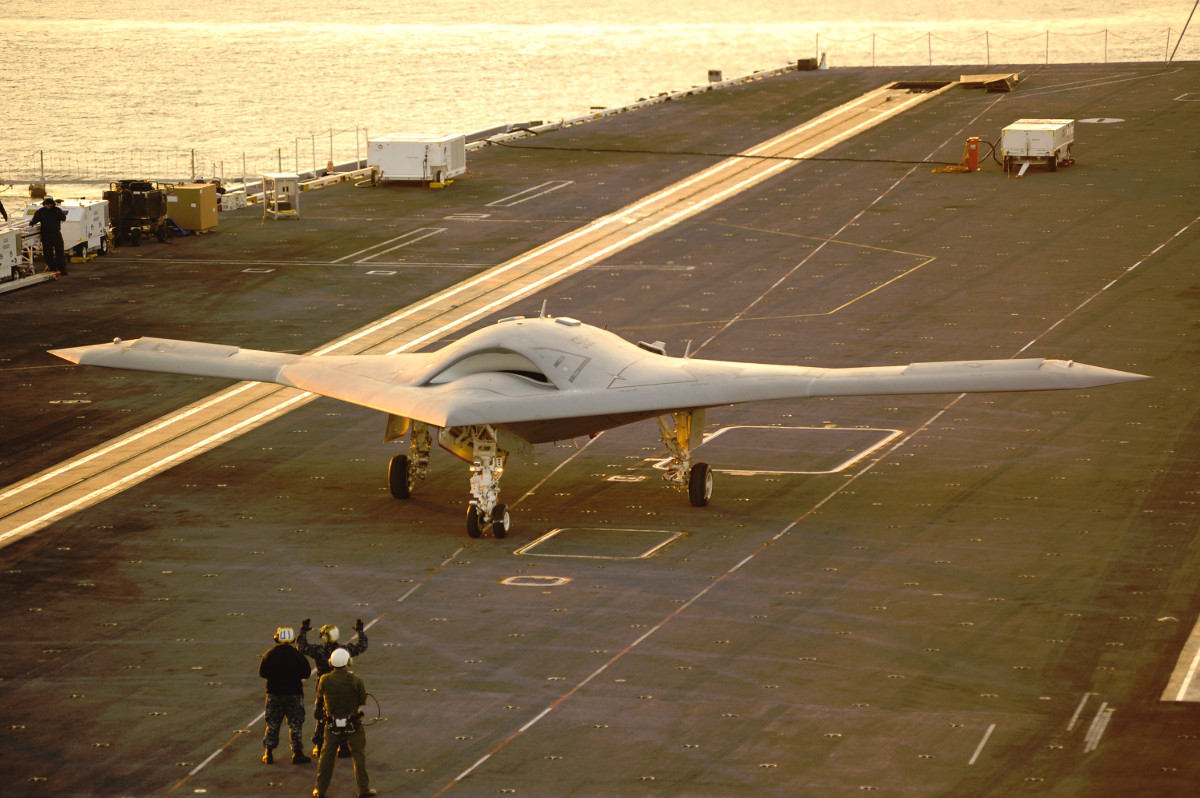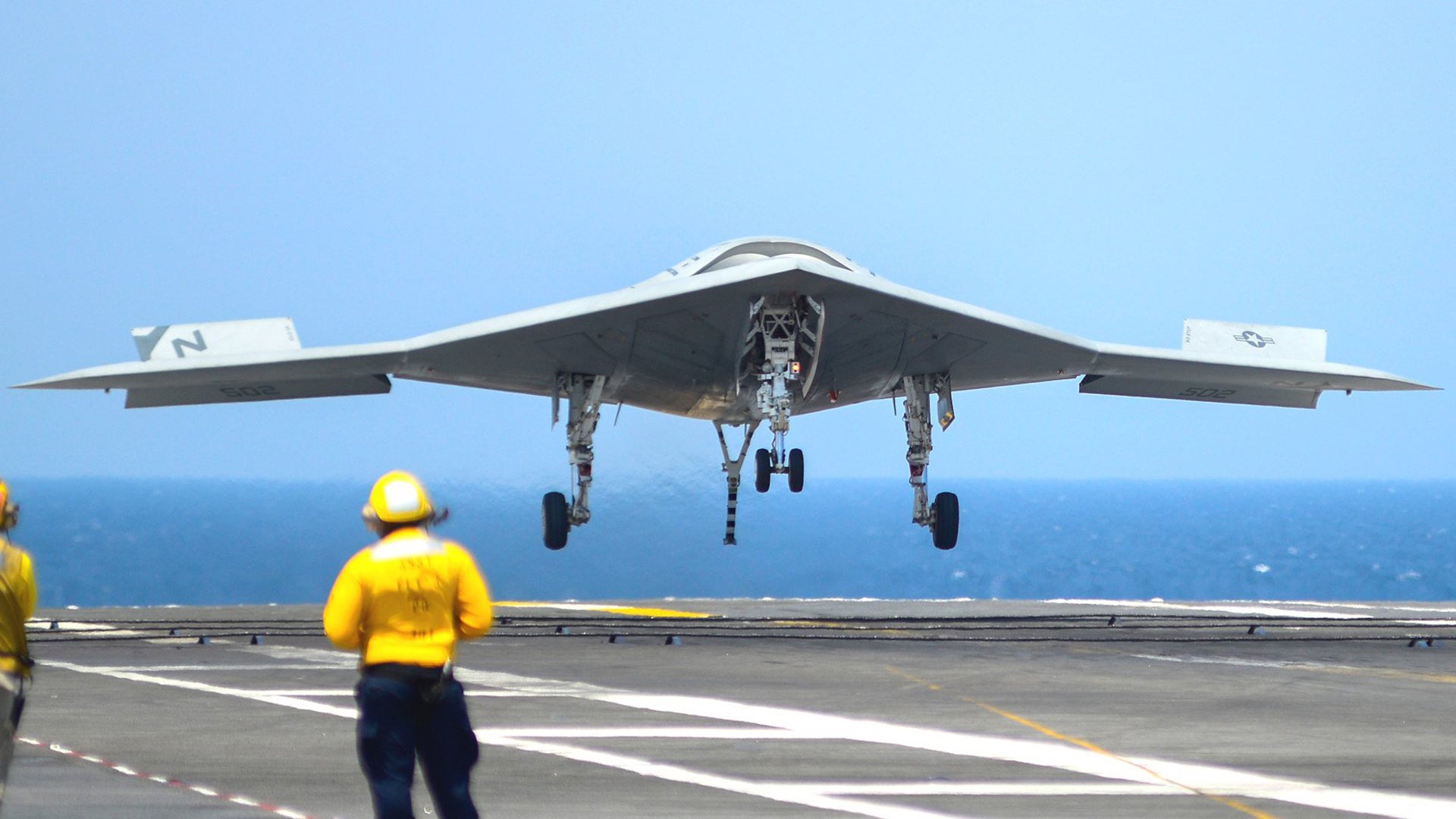In a significant turn of events, despite having been seeing as one of, if not the leading firm involved the program, Northrop Grumman has revealed it will not submit a bid for the U.S. Navy’s MQ-25 Stingray tanker drone competition. The decision suggests that company felt it could not significantly resdesign its existing X-47B unmanned aircraft, or develop an entirely new aircraft, and still make a competitive offer.
Northrop Grumman CEO Wesley Bush made the announcement during a phone call with reporters on Oct. 25, 2017. He added that this was the third time the company had decided to drop out of a major aircraft procurement program in the past decade. The firm pulled out of the KC-X tanker competition in 2010 and decided to withdraw its bid for the T-X trainer program earlier in 2017. The Navy released the final MQ-25 request for proposals (RFP) to Boeing, General Atomics, Lockheed Martin, and Northrop Grumman in October 2017 and the other three are still vying for the contract, which the service expects to award in September 2018.
“We really look … under terms of [the] RFP to make sure we can execute,” Bush explained, according to a series of Tweets from FlightGlobal’s Leigh Giangreco. “You might say we’re a little tough on ourselves, but I demand and the company demands we’re clear eyed about that.”
Bush said Northrop Grumman did not feel it could “put forward an attractive offer” that met the Navy’s demands. However, he stressed that the decision wasn’t solely based on whether or not the company could win.
The announcement offers important hints as to how the competition might go over the coming months. Aviation analysts and experts had widely viewed Northrop Grumman as a leading candidate to build the MQ-25.
This was in no small part due to the extensive and unique experience in building unmanned aircraft for the Navy that the company already had in its portfolio. Northrop Grumman’s two X-47B demonstrators, a deliberately stealthy flying wing design, had essentially written the book on carrier-based drones in extensive tests that ran from 2011 into 2015.

The X-47Bs were the first fixed wing unmanned aircraft to perform a catapult launch from an aircraft carrier and first to land autonomously back on the ship. The experimental pilotless planes were also the first to link up with an aerial tanker using a probe-and-drogue type refueling system.

The Navy had said that this Unmanned Combat Air System Demonstrator (UCAS-D) project would be a lead in to the competitive Unmanned Carrier-Launched Airborne Surveillance and Strike (UCLASS) program. The goal would be to build a low-observable unmanned combat aircraft that would be able to sneak past advanced integrated air defenses to perform precision strikes or persistent intelligence, surveillance and reconnaissance missions.
We at the War Zone have written extensively about the transformation of the Navy’s requirements from the UCLASS vision to an almost completely different request for a tanker drone with a secondary intelligence, surveillance and reconnaissance capability. So, Northrop Grumman’s decision not to compete is an important development, but not one that’s necessarily surprising.

It was already clear that the requirements Navy’s revised MQ-25 program, also known as the Carrier-Based Aerial-Refueling System (CBARS), could scuttle any firm’s plans to use its existing stealthy concepts. Rob Weiss, in charge of Lockheed’s famous Skunk Works, had already gone on record saying he expected all the competitors to have to significantly revise their designs.
As I wrote in July 2017:
The shift in requirements to a tanker with secondary intelligence gathering capability already suggested manufacturers might rework their proposals around less costly non-stealthy designs. “From our viewpoint, the requirements, as they are currently unfolding, are going to require a new design from all of the competitors,” Rob Weiss, head of Lockheed’s Skunk Works advanced projects office, told USNI in March 2017.
…
Of course, there is always the possibility one or more of the four contractors could put forward a stealthy tanker design. There is growing evidence that aerial refuelers, manned or unmanned, are increasingly vulnerable in high threat environments in general. In May 2017, a Russian fighter jet intercepted and then did a barrel roll atop an Air Force KC-10 flying over Syria, underscoring this potential danger. But unless all of the competitors decide to go this route, anyone who does might be stuck making an offer that is significantly more expensive and less attractive as a result.
When a photograph emerged of one of the X-47Bs with an air refueling or “buddy” store, which contains its own retractable fuel line with a receptacle “basket” at the end, there was no new information to suggest it wasn’t still reasonable to question whether this combination would be a viable contender. Not only was it unclear whether the existing design had the space to hold the required to be able to supply the required 2,200 gallons of fuel 500 miles away from the carrier’s deck, but also whether it would be cost effective for Northrop Grumman to reconfigure it for this new mission.
The latter point seems especially pertinent, since any stealth aircraft is going to be more expensive than a non-stealthy one as a rule. It is easy to interpret Northrop Grumman CEO Bush’s comments as an acknowledgement that an X-47B-derived tanker could’ve been overly expensive and that there was no interest in producing a new, clean-sheet design.
But it is still interesting that Northrop Grumman chose to withdraw and effectively abandon nearly four years of experience working directly with the Navy on unmanned carrier aviation for the foreseeable future. That’s not counting even more work on unmanned combat aircraft for the service stretching back to the early 2000s, either. If the MQ-25 program moves ahead as expected, it will be the service’s first operational pilotless carrier aircraft and could serve as the basis for variants tasked with additional missions, something that General Atomics has already indicated is the case.

Opting out now could cut the company out of the potential for immediate sales, as well as putting them at a disadvantage in future programs. The War Zone’s own Tyler Rogoway had similar questions about why the firm decided to suddenly pull out of the T-X trainer competition. Northrop Grumman’s entry for that program leveraged significant experience from its existing T-38 trainer.
As in that case, it is entirely possible that Northrop Grumman decided its energies were best spent elsewhere. The company is already deeply invested in developing the B-21 Raider stealth bomber for the U.S. Air Force and is very active in clandestine unmanned projects. In his conference call, Bush specifically noted that his company’s drone projects were “broadly doing well.”
There’s also the distinct possibility the decision could be linked, at least in part, to Northrop Grumman’s purchase of Orbital ATK, a deal that will set the company back nearly $8 billion immediately. This will undoubtedly cost even more in total as the firm has decide how best to integrate the large portfolio of diverse new business divisions. As a result, it might feel that it does not have resources to spare to make a viable bid for the MQ-25.
With Northrop Grumman out of the running, it will be interesting to see how the other competitors respond. Boeing and Lockheed Martin have yet to show detailed artwork depicting their designs. In the meantime, General Atomics’ MQ-25 concept looks to have turned the tables and brought that firm from being a dark horse contender in the UCLASS project to a leading competitor in present CBARS program, something we’ve discussed in detail in the past.
With General Atomics now firmly out in front, it is entirely possible that either Boeing or Lockheed Martin could decide to drop out and refocus their own efforts on other projects.
Contact the author: joe@thedrive.com
